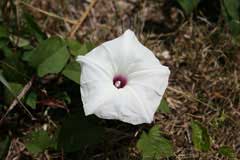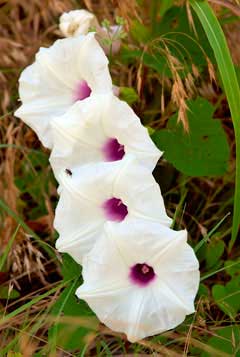 |
|
http://en.wikipedia.org/wiki/User:IvanTortuga |
 |
| http://www.flickr.com/photos/dbarronoss/ |
Translate this page:
Summary
Physical Characteristics

 Ipomoea pandurata is a PERENNIAL CLIMBER growing to 3.5 m (11ft 6in) at a fast rate.
Ipomoea pandurata is a PERENNIAL CLIMBER growing to 3.5 m (11ft 6in) at a fast rate.
See above for USDA hardiness. It is hardy to UK zone 7. It is in flower from June to August. The species is hermaphrodite (has both male and female organs).
Suitable for: light (sandy), medium (loamy) and heavy (clay) soils and prefers well-drained soil. Suitable pH: mildly acid, neutral and basic (mildly alkaline) soils. It cannot grow in the shade. It prefers moist soil.
UK Hardiness Map
US Hardiness Map
Synonyms
Convulvulus candicans. C. panduratus.
Plant Habitats
Cultivated Beds;
Edible Uses
Edible Parts: Root
Edible Uses:
Root - cooked[85]. The young ones are best[62], they become very acrid as they get old[4]. The roots can be up to 75cm long and 12cm in diameter[4, 207] and can weigh 7 kilos[207]. Roots weighing 10 kilos or more are not unknown[274]. They are best if given a long roasting[95]. Roasted roots taste like sweet potato but with some bitterness[207].
References More on Edible Uses
Medicinal Uses
Plants For A Future can not take any responsibility for any adverse effects from the use of plants. Always seek advice from a professional before using a plant medicinally.
Cathartic Diuretic Expectorant
A poultice of the root is applied to aching joints in the treatment of rheumatism[222, 257]. A tea made from the dried root is diuretic, expectorant and laxative[4, 222, 257]. It has been used in the treatment of strangury and calculus diseases, abdominal pains etc[257]. It also slightly influences the lungs, liver and kidneys without excessive diuresis or catharsis[4, 257]. Caution should be employed because the plant can be strongly laxative[21].
References More on Medicinal Uses
The Bookshop: Edible Plant Books
Our Latest books on Perennial Plants For Food Forests and Permaculture Gardens in paperback or digital formats.

Edible Tropical Plants
Food Forest Plants for Hotter Conditions: 250+ Plants For Tropical Food Forests & Permaculture Gardens.
More

Edible Temperate Plants
Plants for Your Food Forest: 500 Plants for Temperate Food Forests & Permaculture Gardens.
More

More Books
PFAF have eight books available in paperback and digital formats. Browse the shop for more information.
Shop Now
Other Uses
Repellent
An infusion of the plant has been used for soaking sweet potatoes in order to keep away bugs and moles[257].
Special Uses
Food Forest
References More on Other Uses
Cultivation details
Requires a rich well-drained loam in a warm sunny position[200]. The hardiest member of the genus, it tolerates frozen soil and should survive winter temperatures down to at least -10°c[260]. A climbing plant, supporting itself by twining around the branches of other plants[219]. A very ornamental plant[1]. This species has become a troublesome weed in many warm countries and is difficult to eradicate because of its deep root[219]. For polyculture design as well as the above-ground architecture (form - tree, shrub etc. and size shown above) information on the habit and root pattern is also useful and given here if available. Growth habit is a single or multiple shooting vine from a crown [1-2]. Herbaceous. The root pattern is a tap root similar to a carrot going directly down [1-2]. The root pattern is tuberous with swollen potato-like roots [1-2].
References Carbon Farming Information and Carbon Sequestration Information
Temperature Converter
Type a value in the Celsius field to convert the value to Fahrenheit:
Fahrenheit:
The PFAF Bookshop
Plants For A Future have a number of books available in paperback and digital form. Book titles include Edible Plants, Edible Perennials, Edible Trees,Edible Shrubs, Woodland Gardening, and Temperate Food Forest Plants. Our new book is Food Forest Plants For Hotter Conditions (Tropical and Sub-Tropical).
Shop Now
Plant Propagation
Pre-soak the seed for 12 hours in warm water, or scarify the seed, and sow in individual pots in a greenhouse in early spring. The seed usually germinates in 1 - 3 weeks at 22°c. Plants are extremely resentful of root disturbance, even when they are quite small, and should be potted up almost as soon as they germinate[219]. Grow them on in the greenhouse for at least their first winter then plant them out into their permanent positions in late spring or early summer, after the last expected frosts. Cuttings of side shoots in a peaty soil. Layering.
Other Names
If available other names are mentioned here
Native Range
NORTHERN AMERICA: Canada, Ontario (south), United States, Indiana, Ohio, Pennsylvania (south), Illinois (south), Kansas (east), Missouri, Oklahoma, Alabama, Arkansas, Florida (north & central), Georgia, Kentucky, Louisiana, Maryland, Mississippi, North Carolina, South Carolina, Tennessee, Virginia, Texas (east),
Weed Potential
Right plant wrong place. We are currently updating this section.
Please note that a plant may be invasive in one area but may not in your area so it's worth checking.
Conservation Status
IUCN Red List of Threatened Plants Status :

Growth: S = slow M = medium F = fast. Soil: L = light (sandy) M = medium H = heavy (clay). pH: A = acid N = neutral B = basic (alkaline). Shade: F = full shade S = semi-shade N = no shade. Moisture: D = dry M = Moist We = wet Wa = water.
Now available:
Food Forest Plants for Mediterranean Conditions
350+ Perennial Plants For Mediterranean and Drier Food Forests and Permaculture Gardens.
[Paperback and eBook]
This is the third in Plants For A Future's series of plant guides for food forests tailored to
specific climate zones. Following volumes on temperate and tropical ecosystems, this book focuses
on species suited to Mediterranean conditions—regions with hot, dry summers and cool, wet winters,
often facing the added challenge of climate change.
Read More
Expert comment
Author
(L.)G.Mey.
Botanical References
43200274
Links / References
For a list of references used on this page please go here
Readers comment
| Add a comment |
|
If you have important information about this plant that may help other users please add a comment or link below. Only comments or links that are felt to be directly relevant to a plant will be included. If you think a comment/link or information contained on this page is inaccurate or misleading we would welcome your feedback at [email protected]. If you have questions about a plant please use the Forum on this website as we do not have the resources to answer questions ourselves.
* Please note: the comments by website users are not necessarily those held by PFAF and may give misleading or inaccurate information.
To leave a comment please Register or login here All comments need to be approved so will not appear immediately.
|
Subject : Ipomoea pandurata
|
|
|
|